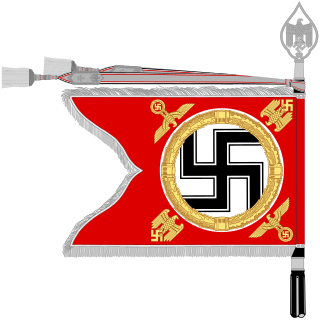
The German Army is the land component of the armed forces of Germany. The present-day German Army was founded in 1955 as part of the newly formed West German Bundeswehr together with the Marine and the Luftwaffe. As of January 2022, the German Army had a strength of 62,766 soldiers.
The Panzergrenadier Division "Großdeutschland", also commonly referred to simply as Großdeutschland or Großdeutschland Division, was an elite combat unit of the German Army that fought on the Eastern Front in World War II.

Felix Martin Julius Steiner was a German SS commander during the Nazi era. During World War II, he served in the Waffen-SS, the combat branch of the SS, and commanded several SS divisions and corps. He was awarded the Knight's Cross of the Iron Cross with Oak Leaves and Swords. Together with Paul Hausser, he contributed significantly to the development and transformation of the Waffen-SS into a combat force made up of volunteers and conscripts from both occupied and un-occupied lands.
The Panzerkorps Großdeutschland was a German panzer corps in the Wehrmacht which saw action on the Eastern Front in 1944/1945 during World War II.

III Army Corps was a corps level formation of the German Army during World War II.
The III (Germanic) SS Panzer Corps was a Waffen-SS armoured corps which saw action on the Eastern Front during World War II. The (Germanische) part of its designation was granted as it was composed primarily of foreign volunteer formations.
The II SS Panzer Corps was a German Waffen-SS armoured corps which saw action on both the Eastern and Western Fronts during World War II. It was commanded by Paul Hausser during the Third Battle of Kharkov and the Battle of Kursk in 1943 and by Wilhelm Bittrich on the Western Front in 1944.
The Panzerkorps Feldherrnhalle was a German army corps that fought on the Eastern Front during the Second World War. It was formed of Sturmabteilung (SA) members. Unlike the Waffen-SS, Feldherrenhalle operated under the Wehrmacht Heer.
The XXXIX Panzer Corps was a German panzer corps which saw action on the Western and Eastern Fronts during World War II.
A panzer corps was an armoured corps type in Nazi Germany's Wehrmacht during World War II. The name was introduced in 1941, when the motorised corps were renamed to panzer corps. Panzer corps were created throughout the war, and existed in the Army, the Waffen-SS and even the Luftwaffe. Those renamed from ordinary motorised corps retained their numbering.

The Führerbegleitbrigade was a German armoured brigade and later an armoured division (Panzer-Führerbegleitdivision), in World War II. It grew out of the original Führer-Begleit-Battalion formed in 1939 to escort and protect Adolf Hitler at the front. It was formed in November 1944 and destroyed in April 1945.

The Heiligenbeil Pocket or Heiligenbeil Cauldron was the site of a major encirclement battle on the Eastern Front during the closing weeks of World War II, in which the Wehrmacht's 4th Army was almost entirely destroyed during the Soviet Braunsberg Offensive Operation. The pocket was located near Heiligenbeil in East Prussia in eastern Germany, and the battle, part of a broader Soviet offensive into the region of East Prussia, lasted from 26 January until 29 March 1945.
The XXVII Corps was an infantry corps in the German army. It fought in several notable actions during World War II.
Fallschirm-Panzergrenadier-Division 2 "Hermann Göring" was a German military unit formed on 24 September 1944 in the area of Radom. It subsequently was joined with the Fallschirm-Panzer Division 1 Hermann Göring to form the Fallschirm Panzer Corps Hermann Göring. After heavy fighting against the Soviet Army in Prussia, Pomerania, Silesia, and Saxony, the Corps surrendered to Soviet troops on May 8, 1945.
The Mirgorod direction offensive was an operation conducted as part of Operation Polkovodets Rumyantsev between the Red Army and Wehrmacht forces. It was one of the operations that followed the Battle of Kursk. In the offensive, the Red Army pushed through the Wehrmacht lines after the Wehrmacht retreated after the Battle of Kursk. It represented a turning point on the Eastern Front.
Panzer-Division Clausewitz was a German panzer division during World War II, named for Carl von Clausewitz.
The LXXVI Panzer Corps was a panzer corps of Nazi Germany during World War II. The headquarters were formed in France under Army Group D on 29 June 1943 as LXXVI Army Corps but renamed a month later. In August it shipped to Italy to become part of 10th Army. It spent the rest of the war in Italy fighting in the Italian Campaign mainly under 10th Army but with short periods from February 1944 and January 1945 under 14th Army. The Corps was commanded for most of its active fighting by General Traugott Herr.

The 25th Infantry Division was a military unit of the German Wehrmacht. It was later reclassified to 25th Motorized Infantry Division, and in June 1943 to the 25th Panzergrenadier Division.

Operation Southwind was a German offensive operation on the Eastern Front in Hungary, from 17–24 February 1945. The Germans succeeded in eliminating the Soviet bridgehead on the west bank of the river Hron in preparation for Operation Spring Awakening. This was one of the last successful German offensives in the Second World War.
The XI SS Corps was a Waffen-SS corps created on July 24, 1944 in southern Poland on the basis of the remains of the headquarters of the defeated V Army Corps and employed on the Eastern Front in 1944-1945 during World War II.
This page is based on this
Wikipedia article Text is available under the
CC BY-SA 4.0 license; additional terms may apply.
Images, videos and audio are available under their respective licenses.






